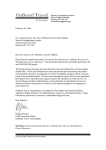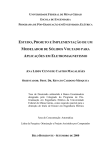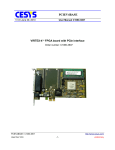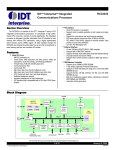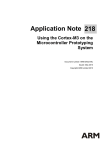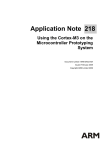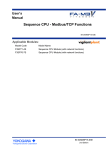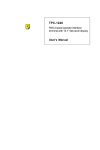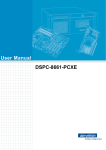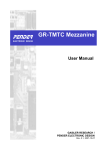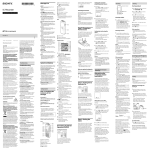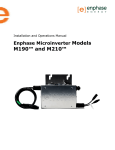Download GR-CPCI-LEON4-N2X Development Board User Manual
Transcript
GR-CPCI-LEON4-N2X Development Board User Manual AEROFLEX GAISLER AB Rev. 1.2, 2013-08-27 2 GR-CPCI-LEON4-N2X Development Board User Manual Information furnished by Aeroflex Gaisler AB is believed to be accurate and reliable. However, no responsibility is assumed by Aeroflex Gaisler AB for its use, nor for any infringements of patents or other rights of third parties which may result from its use. No license is granted by implication or otherwise under any patent or patent rights of Aeroflex Gaisler AB. Aeroflex Gaisler AB tel +46 31 7758650 Kungsgatan 12 fax +46 31 421407 411 19 Göteborg [email protected] Sweden www.aeroflex.com/gaisler Copyright © 2013 Aeroflex Gaisler All information is provided as is. There is no warranty that it is correct or suitable for any purpose, neither implicit nor explicit. © Aeroflex Gaisler AB August 2013, Rev. 1.2 3 GR-CPCI-LEON4-N2X Development Board User Manual TABLE OF CONTENTS 1 INTRODUCTION.........................................................................................................7 1.1 1.2 1.3 1.4 2 Overview................................................................................................................... 7 References................................................................................................................9 Handling.................................................................................................................... 9 Abbreviations........................................................................................................... 10 ELECTRICAL DESIGN.............................................................................................11 2.1 2.2 2.3 2.4 2.4.1 2.4.2 2.4.3 2.5 2.5.1 2.5.2 2.5.3 2.5.4 2.6 2.7 2.7.1 2.7.2 2.8 2.9 2.10 2.11 2.12 2.13 2.14 2.15 2.16 2.16.1 2.16.2 2.16.3 2.16.4 2.16.5 2.16.6 2.16.7 2.17 2.18 LEON4 ASIC........................................................................................................... 11 Board Block Diagram..............................................................................................12 Board Mechanical Configuration..............................................................................13 Memory................................................................................................................... 14 DDR2 RAM.............................................................................................................. 14 PC-100 SDRAM......................................................................................................14 Parallel FLASH........................................................................................................15 PCI Interface........................................................................................................... 16 Host/System Slot Configuration...............................................................................16 Peripheral Slot Configuration...................................................................................17 PCI Reset Circuits...................................................................................................18 33 / 66 MHz PCI Bus Speed....................................................................................18 Ethernet Interface....................................................................................................18 Spacewire (LVDS) Interfaces..................................................................................19 SPW interface circuit...............................................................................................19 SPW Connectors.....................................................................................................20 USB Debug Communication Link............................................................................20 Serial Interface (RS232)..........................................................................................21 FTDI Serial to USB Interface...................................................................................21 MIL-STD-1553 Interface.........................................................................................22 SPI interface............................................................................................................ 23 GPIO....................................................................................................................... 24 Memory Expansion..................................................................................................25 Debug Support Unit Interfaces................................................................................26 Other Auxiliary Interfaces and Circuits....................................................................27 Oscillators and Clock Inputs....................................................................................27 Power Supply and Voltage Regulation....................................................................29 Reset Circuit and Button..........................................................................................32 Watchdog................................................................................................................ 32 JTAG interface........................................................................................................ 32 eASIC JTAG Interface.............................................................................................32 Heatsink/Fan........................................................................................................... 33 Technology Table / Routing Rules...........................................................................34 Layer Stack-up........................................................................................................ 36 3 SETTING UP AND USING THE BOARD.................................................................38 4 INTERFACES AND CONFIGURATION....................................................................40 4.1 4.2 4.3 List of Connectors...................................................................................................40 List of Oscillators, Switches and LED's...................................................................50 List of Jumpers........................................................................................................52 © Aeroflex Gaisler AB August 2013, Rev. 1.2 4 GR-CPCI-LEON4-N2X Development Board User Manual LIST OF TABLES Table 2-1: GPIO Definitions.......................................................................................................... 25 Table 2-2: DIP Switch S3 Definitions.............................................................................................25 Table 2-3: Vcore Voltage Adjustment Settings...............................................................................30 Table 2-4: Technology Table /Routing Rules Summary.................................................................36 Table 3-1: Default Status of Jumpers/Switches..............................................................................38 Table 4-1: List of Connectors......................................................................................................... 40 Table 4-2: J1A (Top) RJ45 10/100/1000 Mbit/s Ethernet Connector 1.........................................43 Table 4-3: J1B (Bottom) RJ45 10/100/1000 Mbit/s Ethernet Connector 0....................................43 Table 4-4: J2A SPW-DCL – SPW-DCL interface connections .....................................................43 Table 4-5: J2B-J2I SPW-0 – SPW-7 interface connections (8x)...................................................44 Table 4-6: J3 USB type Mini AB connector – USB Debug Communication Link...........................44 Table 4-7: J4 PIO Header Pin out..................................................................................................44 Table 4-8: J5 USB type Mini AB connector – FTDI Dual Serial Communication Link....................45 Table 4-9: J6 -UART-0 Header for Serial UART 0 signals.............................................................45 Table 4-10: J7 – UART-1 Header for Serial UART 1 signals..........................................................45 Table 4-11: J8- SPI Header for User SPI interface........................................................................45 Table 4-12: Expansion connector J9 Pin-out..................................................................................46 Table 4-13: J10 USER– JTAG Connector .....................................................................................47 Table 4-14: J11 ASIC – JTAG Connector .....................................................................................47 Table 4-15: J12 POWER – External Power Connector..................................................................47 Table 4-16: J13 POWER – External Power Connector..................................................................48 Table 4-17: J14 – Dual MIL-STD-1553 Interface signals................................................................48 Table 4-18: J15 DDR2 SODIMM - 200 pin socket for DDR2 SODIMM.........................................49 Table 4-19: J16 DDR2 SODIMM - 200 pin socket for DDR2 SODIMM.........................................50 Table 4-20: List and definition of Oscillators and Crystals..............................................................51 Table 4-21: List and definition of PCB mounted LED's...................................................................51 Table 4-22: List and definition of Switches.....................................................................................51 Table 4-23: DIP Switch S1 'PIO[7..0]' definition.............................................................................52 Table 4-24: DIP Switch S2 'PIO[15..8]' definition............................................................................52 Table 4-25: DIP Switch S3 definition..............................................................................................52 Table 4-26: List and definition of PCB Jumpers.............................................................................53 LIST OF FIGURES Figure 1-1: GR-CPCI-LEON4-N2X Development Board..................................................................7 Figure 2-1: LEON4 SOC Block Diagram........................................................................................11 Figure 2-2: LEON4-N2X-ASIC-DEMO............................................................................................12 Figure 2-3: Block Diagram of GR-CPCI-LEON4-N2X board..........................................................12 Figure 2-4: GR-CPCI-LEON4-N2X Board with CPCI Front Panel .................................................13 Figure 2-5: Block diagram for PCI System Slot connections..........................................................16 Figure 2-6: Block diagram of PCI Peripheral connections..............................................................17 Figure 2-7: Block diagram of Ethernet GMII/MII Interface .............................................................19 Figure 2-8: SPW flex connection....................................................................................................20 Figure 2-9: USB Host Controller PHYsical Interface......................................................................21 Figure 2-10: Serial interface........................................................................................................... 21 Figure 2-11: Block diagram of FTDI Serial/JTAG to USB Interface...............................................22 Figure 2-12: MIL-STD-1553 Transceiver and Transformer circuit .................................................23 Figure 2-13: Ribbon cable connection to front Panel D-SUB connectors.......................................23 © Aeroflex Gaisler AB August 2013, Rev. 1.2 5 GR-CPCI-LEON4-N2X Development Board User Manual Figure 2-14: SPI Interface Configuration........................................................................................24 Figure 2-15: PIO interface.............................................................................................................. 24 Figure 2-16: Debug Support Unit connections................................................................................27 Figure 2-17: Board level Clock Distribution Scheme......................................................................28 Figure 2-18: Power Regulation Scheme.........................................................................................31 Figure 2-19: Watchdog configuration.............................................................................................32 Figure 2-20: Layer Stack-up (TBC)................................................................................................37 Figure 4-1: Front Panel View .........................................................................................................41 Figure 4-2: PCB Top View.............................................................................................................. 53 Figure 4-3: PCB Bottom View.........................................................................................................54 Figure 4-4: PCB Top View (Photo).................................................................................................55 Figure 4-5: PCB Bottom View (Photo)............................................................................................56 REVISION HISTORY Revision Date 0.0 DRAFT Page Description All Draft Table 4-12 Pin READ removed from connector J9 1.0 2013-04-09 All Updated text to match 'as-built' hardware description, with rev 1.1 hardware, and made various corrections. 1.1 2013-08-27 All Various corrections and updates after review. 1.2 2013-08-27 2-4, 2-8,2-13 Updated figures. Table 3-1. Corrected for JP11. §1.2, §2.14 Added note about expansion connector pin numbering and added a link to reference document about Mezzanine Connectors §2.16.2 Modified text description of Vcore adjustment © Aeroflex Gaisler AB August 2013, Rev. 1.2 6 GR-CPCI-LEON4-N2X Development Board User Manual Intentionally Blank © Aeroflex Gaisler AB August 2013, Rev. 1.2 7 1 GR-CPCI-LEON4-N2X Development Board User Manual INTRODUCTION 1.1 Overview This document describes the GR-CPCI-LEON4-N2X Development Board. The purpose of this equipment is to provide developers with a convenient hardware platform for the evaluation and development of software for the Aeroflex Gaisler LEON4-N2X Processor for the LEON4FT-NGMP project. The LEON4 processor is a 32-bit processor compliant to the SPARC V8 architecture. In this variant, Aeroflex Gaisler has implemented a Multi-Core LEON4FT processor with a rich set of IP cores and interfaces in a eASIC Nextreme2 structured ASIC. The GR-CPCI-LEON4-N2X Development Board comprises a custom designed PCB in a 6U Compact PCI format, making the board suitable for stand-alone bench top development, or if required, to be mounted in a 6U CPCI Rack. The principle interfaces and functions are accessible on the front and back edges of the board, and secondary interfaces via headers on the board. Figure 1-1: GR-CPCI-LEON4-N2X Development Board © Aeroflex Gaisler AB August 2013, Rev. 1.2 8 GR-CPCI-LEON4-N2X Development Board User Manual The board contains the following main items as detailed in section 2 of this document: • LEON4-N2X ASIC with Multi-Core Leon4FT architecture • CPCI Interface • Memory • DDR2-600 SDRAM • PC-100 SDRAM • Parallel Boot FLASH 1 slot 96 bits wide, DDR2-SODIMM 1 bank 96 bits wide, Discrete chips 64 Mbit (16bit wide x 4M or 8bit wide x 8M) • Power, Reset, Clock and Auxiliary circuits • Interface circuits required for the features listed below The interface connectors on the Front edge of the board provide: • Dual RJ45 10/100/1000 Mbit GMII/MII Ethernet interface (KSZ9021GN with RJ45 jack) • 8 port SPW interface (8 x MDM9S) • SPW Debug Comm. Link (MDM9S) • USB2.0 Debug Comm. Link Interface (ISP1504A with USB-Mini-AB) • 16 bit General Purpose I/O (34 pin 0.1” ribbon cable style connector) • FTDI Serial to USB interface (FT2232HL with USB-Mini-AB) The interface connectors on the Back edge of the board provide: • Compact PCI interface (32 bit, 33/66MHz), configurable for Host or Peripheral slot • Input power connector (+5V nom.) To enable convenient connection to the interfaces, most connector types and pin-outs are compatible with the standard connector types for these types of interfaces. Additionally, on-board headers and components provide access to the following functions/ features: • Dual MIL-1553 Interface (can be connected to front panel with short ribbon cable connection to a D-sub 9 Male connector) • DIP switches for GPIO signal configuration • DIP Switch for Memory interface configuration • LED indicators connected to GPIO signals • SPI interface user connections on 0.1” header • Two Serial UART (RS232) interfaces (can be connected to front panel with short ribbon cable connection with D-sub 9 female connectors) • JTAG Debug interface • Test connector for access to eASIC JTAG interface • 4 pin Molex style power connector • Push Buttons for RESET and DSU-BREAK • LED indicators for POWER, ERRORN, DSU Active and GPIO • Assorted jumpers and Test Points for configuration and Test of the board © Aeroflex Gaisler AB August 2013, Rev. 1.2 9 GR-CPCI-LEON4-N2X Development Board User Manual Debug interface support is demonstrated on the board with support for debugging via the following interfaces: • • • • JTAG ETH (EDCL) USB (USB-DCL) SPW (SPW-DCL) Please note that the LEON4-N2X device has errata that affects interfaces such as the PCI interface. Please refer to the errata section of RD-4. 1.2 References RD-1 GR-CPCI-LEON4-N2X_schematic.pdf, Schematic (included on CD) RD-2 GR-CPCI-LEON4-N2X_assy_drawing.pdf, Assembly Drawing (included on CD) RD-3 GR-CPCI-LEON4-N2X_bom.pdf, Bill of Materials (included in CD) RD-4 LEON4-N2X Data Sheet and User’s Manual, Aeroflex Gaisler, latest version is available via http://www.gaisler.com/gr-cpci-leon4-n2x RD-5 GRMON2 User Manual, Aeroflex Gaisler, part of GRMON2 package. RD-6 GR-MEZZ Technical Note, Technical Note about Mezzanine connectors 1.3 Handling ATTENTION : OBSERVE PRECAUTIONS FOR HANDLING ELECTROSTATIC SENSITIVE DEVICES This unit contains sensitive electronic components which can be damaged by Electrostatic Discharges (ESD). When handling or installing the unit observe appropriate precautions and ESD safe practices. When not in use, store the unit in an electrostatic protective container or bag. When configuring the jumpers on the board, or connecting/disconnecting cables, ensure that the unit is in an un-powered state. When operating the board in a 'stand-alone' configuration, the power supply should be current limited to prevent damage to the board or power supply in the event of an overcurrent situation. This board is intended for commercial use and evaluation in a standard laboratory environment, nominally, 20°C. All devices are standard commercial types, intended for use over the standard commercial operating temperature range (0 to 70ºC). © Aeroflex Gaisler AB August 2013, Rev. 1.2 10 GR-CPCI-LEON4-N2X Development Board User Manual 1.4 Abbreviations ASIC CPCI DIL DDR DSU ESD GPIO I/O IP MII MUX PCB GMII SOC SPW TBC Application Specific Integrated Circuit. Compact Peripheral Connect Interface Dual In-Line Double Data Rate Debug Support Unit Electro-Static Discharge General Purpose Input / Output Input/Output Intellectual Property Media Independent Interface Multiplexer Printed Circuit Board Gigibit Media Independent Interface System On a Chip Spacewire To be Confirmed © Aeroflex Gaisler AB August 2013, Rev. 1.2 11 2 GR-CPCI-LEON4-N2X Development Board User Manual ELECTRICAL DESIGN 2.1 LEON4 ASIC The Aeroflex Gaisler LEON4 processor core is a synthesizable VHDL model of a 32-bit processor compliant with the SPARC V8 architecture. The core is highly configurable and particularly suitable for high performance multi-core system-on-a-chip (SOC) designs. As a technology demonstrator, Aeroflex Gaisler has implemented a representative mulitprocessor LEON4-N2X configuration in a Structured ASIC from eASIC technologies. This design consists of quad core LEON4 processors and a set of IP cores connected through AMBA AHB/APB buses as represented in Figure 2-1, and as specified in RD-4. Figure 2-1: LEON4 SOC Block Diagram This LEON4-N2X ASIC is packaged in a 896-pin, 1mm pitch Flip Chip Ball Grid Array package (31 x 31 mm), and is soldered on to the PCB. The details of the interfaces, operation and programming of the LEON4-N2X ASIC is given in the LEON4-N2X Data Sheet and User’s Manual, RD-4. © Aeroflex Gaisler AB August 2013, Rev. 1.2 12 GR-CPCI-LEON4-N2X Development Board User Manual Figure 2-2: LEON4-N2X-ASIC-DEMO 2.2 Board Block Diagram The GR-CPCI-LEON4-N2X Board provides the electrical functions and interfaces as represented in the block diagram, Figure 2-3. DDR2 DDR2 RAM RAM PC100 PC100 SDRAM SDRAM LEON4 ASIC PARALLEL PARALLEL FLASH FLASH POWER POWER IN IN POWER POWER AND AND REGULATION REGULATION CPCI CPCI 88 xx SPW SPW I/F I/F SPW SPW DUAL DUAL 10/100/1000 10/100/1000 ETHERNET ETHERNET ETHERNET ETHERNET USB-DCL USB-DCL USB-DCL USB-DCL SPW-DCL SPW-DCL SPW-DCL SPW-DCL USER USER I2C I2C I/F I/F I2C I2C I/F I/F USER USER I/O I/O USER USER I/O I/O 22 xx MIL-1553 MIL-1553 I/F I/F 1553 1553 I/F I/F JTAG-DEBUG JTAG-DEBUG JTAG JTAG I/F I/F 22 xx SERIAL SERIAL UART UART I/F I/F RS232 RS232 FTDI FTDI SERIAL SERIAL TO TO USB USB I/F I/F FTDI-USB FTDI-USB COMPACT COMPACT PCI PCI I/F I/F Figure 2-3: Block Diagram of GR-CPCI-LEON4-N2X board © Aeroflex Gaisler AB August 2013, Rev. 1.2 13 GR-CPCI-LEON4-N2X Development Board User Manual 2.3 Board Mechanical Configuration The Main PCB is a 6U Compact PCI format board (233.5 x 160mm) and can be used 'standalone' on the bench-top simply using an external +5V power supply, or can be plugged in to a Compact PCI backplane. Figure 1-1, shows the board as a stand alone PCB. However, for installation into a Compact PCI rack, this board is provided with a custom CPCI front panel with the with the appropriate connector cut-outs. The front panel concept is shown in Figure 2-4, with MDM9S style connectors for the Spacewire interfaces. Figure 2-4: GR-CPCI-LEON4-N2X Board with CPCI Front Panel © Aeroflex Gaisler AB August 2013, Rev. 1.2 14 GR-CPCI-LEON4-N2X Development Board User Manual 2.4 Memory The memory configuration installed on the board comprises: • SODIMM socket for SODIMM mounted DDR2 RAM (1 or 2 Gbyte modules) • Discrete PC-100 SDRAM chips providing 96 bit wide interface (6 x 256Mbit) • 128 Mbit of Flash PROM, in Parallel 8 bit flash device Note that, although both DDR2 and SDRAM are provided on the board, only one or the other can be used at one time. This is determined by the state of the mem_ifsel pin at power on of the board. 2.4.1 DDR2 RAM The LEON4-N2X ASIC incorporates a 96 bit wide DDR2 RAM Data interface (64 bits data plus 32 bits EDAC check bits). To accommodate this in a flexible way, two 204 pin DDR2 SODIMM sockets are implemented on board, one socket for the 64 bits data and the second socket (Half used) for the 32 bits EDAC check bit data paths. Due to the size and configuration of the SODIMM sockets, one socket is mounted on the top side and the other socket on the bottom side of the board, in a 'mirror image' as represented in the figure below. Note that the height of the SODIMM socket on the bottom side of the board is approximately 5.2mm. Strictly speaking, the CPCI specification only allows an envelope of 2.54mm for the component heights on the bottom side of the board, and the board is therefore not fully compliant. This is unlikely to cause an actual problem in use, since the volume required by the bottom side socket is most likely to be 'free air' in any normal single or dual slot board mounted in the adjacent slot. However, it will be necessary to take care when installing and removing the card from a PCI rack. Do not simply yank the card out of the rack since this bottom side SODIMM socket will make contact against the front panel of the adjacent card when you try to slide it out of the rack, and this may damage the board. YOU MUST NOT TRY TO USE FORCE TO REMOVE THE CARD! Instead the adjacent card will have to be loosened or removed first in order to allow the GR-CPCILEON4-N2X card to be removed. 2.4.2 PC-100 SDRAM The LEON4-N2X ASIC incorporates a 96 bit wide PC-100 SDRAM Data interface (64 bits data plus 32 bits EDAC check bits). To accommodate this, six 256Mbit Micron MT48LC16M16 devices are soldered on to the © Aeroflex Gaisler AB August 2013, Rev. 1.2 15 GR-CPCI-LEON4-N2X Development Board User Manual board. Each chip provides 16 bit data interface, giving overall a 96 bit wide x 16 Mword SDRAM memory size. 2.4.3 Parallel FLASH This device can be used for Program storage or as a boot device for the board. This device (Intel/Numonyx JS28F640J3 Strataflash) provides 64Mbit of Non-Volatile storage, organised as 4M x 16 bits, operating with an I/O voltage of in the range of 2.7V to +3.3V. However, the prom interface signals of the LEON4-N2X ASIC are implemented on a I/O bank with an I/O voltage of 1.8V (LVCMOS_18). Therefore in order to interface the J3 series flash devices, appropriate voltage translation buffers for the address, control and data lines are implemented. The J3 series flash devices can be configured for either 8 or 16 bit operation, by means of a jumper on the board (JP30). Note: if the PROM width is changed via JP30 then GPIO[10] should also be set to reflect the correct PROM width. Programming of these Flash chips can be performed using the GRMON debug software (RD-5). To allow the User to prevent the contents of the FLASH memory from being overwritten under software control, the Write-Protect pin can be tied to DGND by installing the jumper JP9. Under certain circumstances, it may be desirable to inhibit the operation of the Flash PROM (e.g. if system booting and program loading via Spacewire RMAP protocol is required instead). To facilitate this, a Jumper JP10 is provided which connects/disconnects the ROMSN0 pin of the ASIC to the Chip Enable pin of the FLASH Prom. In normal operation, to boot from this FLASH prom, the jumper should be installed. To inhibit the operation of the FLASH prom, the jumper should be removed. © Aeroflex Gaisler AB August 2013, Rev. 1.2 16 GR-CPCI-LEON4-N2X Development Board User Manual 2.5 PCI Interface The LEON4-N2X ASIC incorporates a 33/66MHz/32 bit interface with 8 channel PCI Arbiter and is capable of being configured to be installed in either the SYSTEM slot (HOST) or in PERIPHERAL slots (GUEST). The GR-CPCI-LEON4-N2X board can be configured to operate either as a peripheral slot card or system slot card as described in the following sections. Note that the GR-CPCI-LEON4-N2X board has been designed to operate in a 3.3V signalling environment, and the Compact PCI connector is appropriately keyed (yellow key). 2.5.1 Host/System Slot Configuration When installed in the System slot, the board provides the PCI arbitration and distributes the required PCI clocks to the backplane, and to the PCI interface in the ASIC. ASIC SYSEN HOST IDSEL IDSEL GND ARBITER REQ GNT REQ7 REQ6 REQ5 REQ4 REQ3 REQ2 REQ1 REQ0 REQ6N REQ5N REQ4N REQ3N REQ2N REQ1N JP12 REQN 4 3 2 1 GNT7 GNT6 GNT5 GNT4 GNT3 GNT2 GNT1 GNT0 GNT6N GNT5N GNT4N GNT3N GNT2N GNT1N JP13 GNTN 4 3 2 1 PCICLKIN 1 3 2 4 PCICLK PCICLK1 PCICLK2 PCICLK3 PCICLK4 PCICLK5 PCICLK6 JP14 BUFFER CPCI EDGE CONNECTOR XTAL 33/66MHz Figure 2-5: Block diagram for PCI System Slot connections This requires the jumpers to be installed as follows: © Aeroflex Gaisler AB JP12 JP13 JP14 1-2 and 3-4 1-2 and 3-4 1-2 and 3-4 August 2013, Rev. 1.2 17 GR-CPCI-LEON4-N2X Development Board User Manual Additionally, the PCI specification requires that the following system signals are pulled-up by the card operating in the system slot: PCI_FRAMEN PCI_STOPN PCI_PAR PCI_IRDYN PCI_PERRN PCI_IDSEL PCI_TRDYN PCI_SERRN PCI_DEVSELN PCI_LOCKN This can be achieved by installing the JP11 jumpers 1-2, 3-4, 5-6, 7-8, 9-10, 11-12, 13-14, 15-16, 17-18 and 19-20. The jumper JP15 should be installed if it is required to force the PCI interface to operate with 33MHz bus speed. 2.5.2 Peripheral Slot Configuration When functioning in a Peripheral slot, the board receives its input clock from the backplane, and connects its REQN/GNTN signals to the backplane REQN/GNTN signals. ASIC HOST IDSEL IDSEL ARBITER REQ GNT REQ7 REQ6 REQ5 REQ4 REQ3 REQ2 REQ1 REQ0 REQ6N REQ5N REQ4N REQ3N REQ2N REQ1N JP12 REQN 4 3 2 1 GNT7 GNT6 GNT5 GNT4 GNT3 GNT2 GNT1 GNT0 GNT6N GNT5N GNT4N GNT3N GNT2N GNT1N JP13 GNTN 4 3 2 1 PCICLKIN 1 3 2 4 PCICLK PCICLK1 PCICLK2 PCICLK3 PCICLK4 PCICLK5 PCICLK6 JP14 BUFFER CPCI EDGE CONNECTOR XTAL 33/66MHz Figure 2-6: Block diagram of PCI Peripheral connections This requires the jumpers to be installed as follows: JP12 JP13 JP14 1-3 2-3 2-3 None of the jumpers in JP11 and JP15 should be installed. © Aeroflex Gaisler AB August 2013, Rev. 1.2 18 GR-CPCI-LEON4-N2X Development Board User Manual 2.5.3 PCI Reset Circuits In Host mode (PCI_HOSTN = low) the ASIC device will keep PCIRSTN on the backplane low until all on-chip PLLs have locked and the AMBA system has completed it's reset (TBD time after RESETN is released). When in Peripheral Mode (PCI_HOSTN = high), the PCI_RSTN signal is not used by the ASIC. In this case, the PCI logic in the device will be in reset until all the following conditions are met: Board RESETN = HIGH,PLLs locked. In order to synchronize the backplane PCIRSTN to the LEON4-N2X's operation it is possible to connect PCIRSTN to the board's reset by strapping 2-3 on JP31. Note that this will only work when the LEON4-N2X does NOT drive its PCI_RST signal (default behaviour when PCI_HOSTN = low). 2.5.4 33 / 66 MHz PCI Bus Speed The LEON4-N2X ASIC is capable of operating either with a 33 MHz or 66 MHz PCI bus speed. If operating as a Host in the System slot, the LEON4-N2X Board is required to provide the PCI Clock to the other slots via the Backplane and an oscillator must be provided on the board (X3). To enable either 33 MHz or 66 MHz to be used, this oscillator is socketed and the user can exchange and install the correct oscillator, as appropriate. A backplane pin M66EN pin is connected to the ASIC, and is intended in the PCI specification to signal to the PCI-Host whether the Backplane/System is capable of operating at 66MHz clock frequency. In principle this could be used to automatically select whether a 33MHz or 66MHz clock is used for the PCI interface. However, there is no mechanism on this board to automatically change this frequency, and the User is instead required to install the desired Oscillator in socket X3 in order to use either 33 or 66 MHz as the PCI frequency when in PCI-Host mode. Note also that 66MHz clocking of PCI is in principle only valid for systems with a maximum of 5 slots. If, in a system capable of 66MHz bus speed, it is for some reason it is required to run the bus at 33MHz, this can be achieved by installing the Jumper JP15, which will force the M66EN of the backplane to DGND. 2.6 Ethernet Interface The LEON4-N2X ASIC device incorporates two Ethernet controllers with support for GMII and MII interfaces, and the GR-CPCI-LEON4-N2X Development Board has two Micrel KSZ9021GN 10/100/1000Mbit/s Ethernet PHY transceivers. These are connected to a dual RJ45 connector on board (J1). For more information on the registers and functionality of the Ethernet MAC+PHY device please refer to the data sheet for the KSZ9021GN device. The GMII Ethernet PHY's are provided with a 125 MHz clock derived from the oscillator X6 on the board. Ethernet Interface 0 has a hard-wire PHY Address of 1 (“001”) on this board. Ethernet Interface 1 has a hard-wire PHY Address of 2 (“010”) on this board. Note that, if using the Ethernet interfaces for the EDCL Debug link, it is necessary to appropriately set the GPIO DIP switches at power-up/reset of the board to Boot-strap the following settings: © Aeroflex Gaisler AB August 2013, Rev. 1.2 19 GR-CPCI-LEON4-N2X Development Board User Manual GPIO[3:0] sets the least significant address nibble of the IP and MAC address for Ethernet Debug Communication Link 0. GPIO[7:4] sets the least significant address nibble of the IP and MAC address for Ethernet Debug Communication Link 1. GPIO[8] Selects if Ethernet Debug Communication Link 0 traffic should be routed over the Debug AHB bus (HIGH) or the Master I/O AHB bus (LOW). GPIO[9] Selects if Ethernet Debug Communication Link 1 traffic should be routed over the Debug AHB bus (HIGH) or the Master I/O AHB bus (LOW). 8 ETH_RXD[7..0] 8 ETH_TXD[7..0] ETH_TXCLK ETH_TXEN ETH_TXER RJ45 RJ45 ETH_RXCLK ETH_ER ETH_RXDV ASIC ASIC ETHERNET ETHERNET GMII GMIIPHY PHY ETH_COL ETH_CRS ETH_MDIO ETH_MDC ETH_MDINT 125MHz 125MHz RESETN ETH_GTXCLK Figure 2-7: Block diagram of Ethernet GMII/MII Interface (one of 2 interfaces shown) 2.7 Spacewire (LVDS) Interfaces The LEON4-N2X ASIC provides nine Spacewire interfaces which are routed to the front panel of the board. Eight of the Spacewire interfaces form an 8-port SpaceWire router/switch with four on-chip AMBA ports with RMAP. The ninth SPW port is dedicated as a SPW Debug interface, as part of the DSU functionality. The board supports a link rate for SpaceWire up to 200 Mbit/s. 2.7.1 SPW interface circuit Each Spacewire interface consists of 4 LVDS differential pairs (2 input pairs and 2 output pairs). As the Spacewire interface to the LEON4-N2X ASIC is LVCMOS (3.3V logic), LVDS driver and receiver circuits are required on the PCB to interface between the ASIC and the © Aeroflex Gaisler AB August 2013, Rev. 1.2 20 GR-CPCI-LEON4-N2X Development Board User Manual external interface. The PCB traces for the LVDS signals on the GR-CPCI-LEON4-N2X board are laid out with 100-Ohm differential impedance design rules and matched trace lengths. 100 Ohm Termination resistors for the LVDS receiver signals are mounted on the board close to the receiver. 2.7.2 SPW Connectors In order to be compatible with other SPW equipment, standard MDM9S connectors are mounted on the CPCI front panel for the Spacewire interfaces. The pin out of the MDM9S connectors for these Spacewire interfaces conform to the Spacewire standard. In order to make the transition from the PCB to the front panel, 40 pin high speed SAMTEC connectors together with a small flex-prints are used, as shown in Figure 2-8. Figure 2-8: SPW flex connection 2.8 USB Debug Communication Link A USB Device link is provided on the board (Connector J4), which is dedicated for the USB Debug Communication link as described in section 2.15 and section 3. The interface between the USB-PHY and the ASIC is ULPI with a clock frequency of 60MHz. Please refer to the device data sheet of the ISP1504A device for further information about the USB PHY device. Note that, to enable this interface, it is necessary that the GPIO[15] pin is pulled 'low' at reset of the board. This can be achieved by setting the DIP Switch S2, switch 8 to 'Closed'. © Aeroflex Gaisler AB August 2013, Rev. 1.2 21 GR-CPCI-LEON4-N2X Development Board User Manual NEXT DP STP DM DIR ASIC ASIC USB USB Mini MiniAB AB DATA[7..0] USB INTERFACE ISP1504A ISP1504A USB USBPHY PHY RESETN_N CLK (60MHz) XTAL XTAL 19.2MHz 19.2MHz Figure 2-9: USB Host Controller PHYsical Interface 2.9 Serial Interface (RS232) The GR-CPCI-LEON4-N2X board, provides RS232 interface circuits and 10 pin headers for two Serial interfaces with TXD/RXD/CTSN/RTSN pins. The RS232 transceiver IC's on this board are SN75C3232 devices from Texas Instruments which operate from a single +3.3V power supply. The layout and pin ordering of the 10 pin headers is designed so that a simple 1-to-1 ribbon cable connection can be made to a 'standard' Female D-Sub 9 pin type connector with a standard pin-out for serial links (see Figure 2-13). TXD ASIC SUB-D 9 pin Female RS232 DRIVER/ RECEIVERS RS232 I/F RXD Figure 2-10: Serial interface Note: As explained in the following section, the serial interfaces of the LEON4-N2X can either be connected to these front panel connectors (RS232) or to the FTDI-USB interface chip, depending on the setting of the jumpers JP17 to JP28. The user should take care to set the appropriate jumper configuration depending on the configuration required. 2.10 FTDI Serial to USB Interface To provide additional flexibility, an FTDI FT2232HL Serial to USB interface chip is provided on board. This device provides two Ports which connect to a single Mini-AB USB connector (J5) on the front panel. This USB port can be connected to a host computer to allow communication over serial interfaces to Host PC's which do not have conventional 9 pin D-sub type RS232 © Aeroflex Gaisler AB August 2013, Rev. 1.2 22 GR-CPCI-LEON4-N2X Development Board User Manual connectors. Additionally, the FTDI FT2232HL chip is also able to perform a JTAG to USB conversion function. This functionality is supported by the latest versions of the GRMON debug software, allowing debugging via the JTAG interface to be performed without requiring a specific JTAG cable. As represented in Figure 2-11, sets of jumpers allow a number of possibilities to be configured: 1. Connect UART1 to RS232 connector J8 2. Connect UART1 to FTDI port A (JP21-24 position 1-2) (JP21-24 position 2-3, JP25-28 pos. 1-2) 3. Connect JTAG-DSU to FTDI port A (JP21-24 position 1-2, JP25-28 pos. 2-3) 4. Connect UART0 to FTDI port B (JP17-20 position 2-3) 5. Connect UART0 to RS232 connector J7 LEON4-FT-MP LEON4-FT-MP ASIC ASIC 4 JP24 JP23 JP22 JP21 UART1 (JP17-20 position 1-2) 4 TXD RXD CTSN RTSN RS232 RS232 TRANSCEIVER TRANSCEIVER UART-1 (J8) 1 1 2 2 3 1 4 2 4 A 3 JTAG TMS TDI TDO TCK JP28 JP27 JP26 JP25 3 FTDI FTDI FT2232RH FT2232RH SERIAL SERIALTO TOUSB USB TRANSCEIVER TRANSCEIVER FTDI (USB - J5) JP20 JP19 JP18 JP17 4 4 2 UART0 TXD RXD CTSN RTSN B 3 4 1 4 5 RS232 RS232 TRANSCEIVER TRANSCEIVER UART-0 (J7) Figure 2-11: Block diagram of FTDI Serial/JTAG to USB Interface 2.11 MIL-STD-1553 Interface The board implements a Dual MIL-STD-1553 interface with a 3.3V Transceiver and Transformer circuits as shown in Figure 4-2. © Aeroflex Gaisler AB August 2013, Rev. 1.2 23 GR-CPCI-LEON4-N2X Development Board User Manual The default configuration of the board supports Long-Stub Coupling configuration. However, short-stub and direct-coupling can also be supported depending on the configuration of resistors which is soldered to the board (see Figure 2-12). Additionally, a 80 Ohm parallel termination can be installed if the 2 pin jumpers are installed. Since there are various 'standard' connectors defined for the connection to MIL-STD-1553 bus, and because of limited PCB area, it has instead been decided to implement 10 pin header on the board. This can be easily connected to a D-sub 9-Male connector on the front panel using a short ribbon one-to-one cable connection (see Figure 2-13). A D-sub 9-Male connector on the front panel is selected as this can be most easily adapted to suit the user's desired connector configuration. Figure 2-12: MIL-STD-1553 Transceiver and Transformer circuit (one of two interfaces shown) Note: Concerning routing on the PCB: Underneath the transformer and associated traces of the MIL-1553 circuit, the PCB planes in the internal layers have been 'removed', and no other traces are routed through this area of the PCB. This is done in order to eliminate any magnetic coupling from the transformer circuit in to the Ground plane. Figure 2-13: Ribbon cable connection to front Panel D-SUB connectors © Aeroflex Gaisler AB August 2013, Rev. 1.2 24 GR-CPCI-LEON4-N2X Development Board User Manual 2.12 SPI interface The LEON4-N2X ASIC also provides an SPI interface for user defined devices. As shown in Figure 2-14 , the SPI interface pins of the LEON4-N2X ASIC are connected to an 10 pin 0.1” header on the board to allow an external circuit SPI circuits to be hooked-up. As an example SPI circuit, the GR-CPCI-LEON4-N2X Board provides an AD7814, Temperature monitor circuit on the board, which is selected with the SPIC_CS0 output of the ASIC. If the SPIC_CS0 signal is to be used for an external SPI circuit, then the zero-ohm resistor must be removed to disable the on-board SPI circuit. Figure 2-14: SPI Interface Configuration 2.13 GPIO The LEON4-N2X ASIC provides 16 general Purpose Input Output signals (3.3V LVCMOS voltage levels). The 16 general Purpose Input Output signals of the ASIC (3.3V LVCMOS voltage levels) are connected to a set of 0.1” pitch pin header connector on the front panel thus allowing easy access to these signals, either individually, or with a ribbon cable connection. A series protection resistor of 470 Ohm is included on each signal at the front panel connector. Weak pull ups (47k) are provided on each of the signals lines on the PCB and additionally a set of DIP Switches allow the user to conveniently set the signal state when the GPIO lines are configured as inputs. When programmed as outputs the DIP switches should be left in the 'open' state. PULL-UP (x16) ASIC 16 GPIO[15..0 ] GPIO[15..0] SERIES (x16) DIP-SW (x16) PCB Figure 2-15: PIO interface © Aeroflex Gaisler AB August 2013, Rev. 1.2 25 GR-CPCI-LEON4-N2X Development Board User Manual Note that the state of the GPIO pins is sampled at power-up or reset of the processor in order to determine initial conditions of a number of internal features, as listed in the table below. GPIO Function Comment 0 EDCL LINK0 MACADDR Bit 0 DIP Switch Closed = '0'; Open = '1' 1 EDCL LINK0 MACADDR Bit 1 DIP Switch Closed = '0'; Open = '1' 2 EDCL LINK0 MACADDR Bit 2 DIP Switch Closed = '0'; Open = '1' 3 EDCL LINK0 MACADDR Bit 3 DIP Switch Closed = '0'; Open = '1' 4 EDCL LINK1 MACADDR Bit 0 DIP Switch Closed = '0'; Open = '1' 5 EDCL LINK1 MACADDR Bit 1 DIP Switch Closed = '0'; Open = '1' 6 EDCL LINK1 MACADDR Bit 2 DIP Switch Closed = '0'; Open = '1' 7 EDCL LINK1 MACADDR Bit 3 DIP Switch Closed = '0'; Open = '1' 8 EDCL LINK0 TRAFFIC DIP Switch Closed = '0'=>MASTER AHB; Open = '1' => DEBUG AHB 9 EDCL LINK1 TRAFFIC DIP Switch Closed = '0'=>MASTER AHB; Open = '1' => DEBUG AHB 10 PROM WIDTH DIP Switch Closed = '0' => 8 bit ; Open = '1' => 16 bit 11 PROM DETECT DIP Switch Closed = '0' => No prom; Open = '1' => Prom present 12 SPW ROUTER ID BIT 0 DIP Switch Closed = '0'; Open = '1' 13 SPW ROUTER ID BIT 1 DIP Switch Closed = '0'; Open = '1' 14 PROM EDAC DIP Switch Closed = '0' => Disable; Open = '1' => Enable 15 USB DCL DIP Switch Closed = '0' => Enable; Open = '1' => Disable Table 2-1: GPIO Definitions To ensure the correct initialisation of the processor, the user should ensure that the initial DIP switch settings are correctly set to set the users' required configuration at power up or reset of the board. After reset, the GPIOs can be used as normal IOs. In particular, since this board has a configurable 16 bit or 8 bit prom interface, the setting of GPIO[10] should be consistent with JP30 in order that the board can successfully execute its program from Prom at start up. Additionally, a DIP switch, S3, is provided to allow the user to conveniently set the state of the functions listed in the table below: SWITCH Function Comment 1 DSU Enable DIP Switch Closed = '0' => DISABLE; Open = '1' => ENABLE 2 BREAK DIP Switch Closed = '0' => Normal; Open = '1' => BREAK 3 MEM_IFSEL DIP Switch Closed = '0' => DDR2; Open = '1' => PC100 4 MEM_IFFREQ According Table 24 of RD-4 5 MEM_IFWIDTH According Table 52 of RD-4 6 MEM_CLKSEL DIP Switch Closed = '0' => TBD; Open = '1' => TBD 7 WATCHDOG DIP Switch Closed => Watchdog can reset processor. DIP Switch Open => Watchdog can not reset processor. 8 Not used Not defined Table 2-2: DIP Switch S3 Definitions © Aeroflex Gaisler AB August 2013, Rev. 1.2 26 GR-CPCI-LEON4-N2X Development Board User Manual 2.14 Memory Expansion The LEON4-N2X ASIC does not support the addition of SRAM memory. However, the following memory bus signals are connected to a 120 pin AMP connector (AMP 5-177984-5), J9: DATA[31..0] ADDR[27..0] WRITEN READ OEN IOSN ROMSN[1..0] BRDYN EXP_CLK RESETN This connector and these signals makes it feasible for users to define peripherals mapped in the processor I/O space and implement mezzanine boards which could be connected to this Development Board in a similar manner to the other GR Development Boards. Note: The EXP_CLK signal can be used to provide a Clock to circuits on the Mezzanine. Depending on the configuration required, this connector pin can be connected to either the MEM_EXTCLK or SD_CLK with a zero-ohm resistor soldered to the board. Figure 2-16 shows the pin numbering scheme as implemented on the expansion connector. Figure 2-16: Mezzanine Connector Pin Number Ordering Please note that this pin ordering does not match exactly the pin ordering which you will find on the Tyco part datasheets for the Mezzanine board mating connectors. The reason for this is explained in more detail in the Technical Note, RD-6. Therefore please take care when designing your own mezzanine boards to take account of this pin ordering. If there is any confusion, or you have any doubts, please do not hesitate to contact [email protected]. Additional dimensional data or Gerber layout information can be provided, if required to aid in the layout of the User's mezzanine board. © Aeroflex Gaisler AB August 2013, Rev. 1.2 27 GR-CPCI-LEON4-N2X Development Board User Manual 2.15 Debug Support Unit Interfaces Program download and debugging to the processor is performed using the GRMON Debug Monitor tool from Aeroflex Gaisler (RD-5). The LEON4-N2X ASIC provides an interface for Debug and control of the processor by means of a host terminal via its DSU interface, as represented in Figure 2-17. Three control signals and a data connection from the Debug Support Unit interface to the processor: DSUEN: This signal is pulled high on the board to enable Debugging The signal can be pulled low with DIP Switch S3-1 to disable the DSU DSUBRE: The push-button switch S4 pulls the DSUBRE signal high to force the processor to halt and enter DSU mode. DSUBRE can also be held high with DIP Switch S3-2 to immediately force a DSU Break on reset of the board. (Under normal operation this switch would be left open in order to prevent it interfering with the Push button). DSUACT: When the processor is halted, the LED will illuminate JTAG EDCL USB-DCL SPW DSUBRE→ DSUACT← DSU I/F HOST TERMINAL/COMPUTER JTAG I/F LEON4 ASIC DSUEN→ Figure 2-17: Debug Support Unit connections To communicate with the processor, four possibilities for the data connection to the processor are provided: SPW-DSU Spacewire Debug Communication Link (connector J2a) JTAG-DCL JTAG Debug Communication Link (connector J10 or J5) USB-DCL USB Debug Communication Link (connector J3) EDCL Ethernet Debug Communication Link (connector J1A (Upper) or J1B (Lower)) GRMON can be used with the above listed interfaces, for more information, please refer to RD-5 and RD-6. © Aeroflex Gaisler AB August 2013, Rev. 1.2 28 GR-CPCI-LEON4-N2X Development Board User Manual 2.16 Other Auxiliary Interfaces and Circuits 2.16.1 Oscillators and Clock Inputs The oscillator and clock scheme for the GR-CPCI-LEON4-N2X Board is shown in Figure 218. The main oscillator providing the SYS_CLK for the GR-CPCI-LEON4-N2X ASIC is a 50 MHz Crystal oscillator. To enable different oscillator frequencies to be used, a DIL socket is provided which accepts 4 pin DIL8 style 3.3V oscillator components. Additionally, oscillators are provided as follows: • • • • • • 33/66 MHz oscillator with zero delay buffer for PCI interface and slots DIL Socket for 100 MHz oscillator to provide a separate clock for the External Memory interface DIL Socket for 50 MHz oscillator to provide a separate clock for the Spacewire interfaces 20 MHz oscillator (Fixed SMD soldered on board) for the MIL-STD-1553 clock 125 MHz oscillator with zero delay buffer for generating the GTX Clock required for the two GMII Ethernet interfaces 19.2 MHz crystal which generates with a PLL inside the USB PHY a 60 MHz clock for USB interface Internally to the ASIC, PLL circuits generate the required clock frequencies and phases as for the following: • Processor Main frequency • DDR2 memory clocks • SDRAM Clock • IP core clocks For more details of the internal PLL structure and clock gating features of the ASIC please refer to RD-4. © Aeroflex Gaisler AB August 2013, Rev. 1.2 29 GR-CPCI-LEON4-N2X Development Board User Manual LEON4-FT-MP LEON4-FT-MP ASIC ASIC SD_CLK OSC OSC TBD TBDMHz MHz ZERO ZERO DELAY DELAY BUFFER BUFFER PC100 PC100SDRAM SDRAM SYS_CLK DIL-8 SOCKET DDR2 DDR2RAM RAM DDR2_CLK OSC OSC TBD TBDMHz MHz MEM_EXT CLK USB_CLK DIL-8 SOCKET FTDI FTDI PHY PHY USB USB PHY PHY XTAL 12 MHz XTAL 19.2 MHz OSC OSC TBD TBDMHz MHz SPW_CLK ETHERNET ETHERNET GMII GMII GTX_CLK0 DIL-8 SOCKET OSC OSC 20 20MHz MHz XTAL 25MHz CLK_1553 SMD ETHERNET ETHERNET GMII GMII GTX_CLK1 OSC OSC 33 33or or66 66MHz MHz ZERO ZERO DELAY DELAY BUFFER BUFFER PCI_CLK ZERO ZERO DELAY DELAY BUFFER BUFFER XTAL 25MHz DIL-8 SOCKET OSC OSC 125 125MHz MHz SMD 7 7 x PCI_SLOTS Figure 2-18: Board level Clock Distribution Scheme 2.16.2 Power Supply and Voltage Regulation A single power supply with a +5V (nominal) / +12V (maximum) is required to power the board. All other necessary voltages on the board are derived from this input using discrete Power circuits on the board (DC/DC or Linear Regulators as appropriate). On board regulators generate the following voltages: • • • • +3.3V for +2.5V for +1.8V for +1.2V for © Aeroflex Gaisler AB the GR-CPCI-LEON4-N2X I/O voltage, interfaces and other peripherals LEON4 PLL supply voltage DDR2 supply voltage LEON4 Vcore voltage August 2013, Rev. 1.2 30 • GR-CPCI-LEON4-N2X Development Board User Manual +0.9V for the DDR2 Termination voltage Appropriate decoupling capacitance is provided for all the supply voltages. The Power Supply structure is significantly over-dimensioned using 10A power modules (PTH08T240W) as the basis, in order to provide for uncertainty and flexibility. The advantage of the selected DCDC power modules is their ease of implementation and the wide allowable input voltage range (+4.5V to +14V). Input Voltage The nominal input voltage for the board is +5V. This input voltage can be connected either to the 2.1mm Jack connector, J13 on the board, or taken from the +5V PCI rail from the PCI Backplane. An additional power input connector J14 is provided on the board, as an alternative to the connector J13. This could be useful as a more convenient connection in the situation that the board would be built in to a 'stand-alone' equipment housing. Note: You must not apply power to the connector J13/J14 when the board is plugged into a CPCI rack. Note: Since the DCDC power modules used have a wide allowable input voltage range (+4.5V to +14V), it is acceptable to supply the board via the J13 connector from any voltage supply in the range +5V to +12V. However, the term '+5V nominal' is used in this description since this is the voltage which the Compact PCI backplane will supply when the board is plugged into a CPCI rack. Vcore adjustment Switch S6 allows a small adjustment of the Vcore voltage to be made, according table 2-3. This feature is not intended as a User adjustment. With the 'as-designed' resistor values, only switches 1 and 2 are used and the voltage settings are as follows: S6 switch 1 S6 switch 2 Effective Resistance Vout OFF OFF 12.1k 1.200 V OFF ON 11.47k 1.225 V ON OFF 10.79k 1.254 V ON ON 10.29k 1.279 V Table 2-3: Vcore Voltage Adjustment Settings Power Sequencing Automatic power-sequencing is implemented on the board. In order to reduce in-rush current, which may damage the eASIC Nextreme-2 device, it is required to power up VCC/VCCPD (+3.3V) and VCCIO (+3.3V) after VDD (1.2V Vcore). In order to achieve this power sequencing, the LEON4-N2X board implements a small power sequencer circuit (ISL8702A). This circuit provides four open drain output flags which are connected to the TRACK pins of the DCDC modules. On power up, the output flags are sequentially released in a timed sequence (ca. 15 ms spacing) © Aeroflex Gaisler AB August 2013, Rev. 1.2 31 GR-CPCI-LEON4-N2X Development Board User Manual The first flag controls the start-up of the Vcore (+1.2V) DCDC converter. The second flag controls the start-up of the VIO (+3.3V and 1.8V) DCDC converters. The third and fourth flags are unused in this configuration. The output flags will follow a reverse sequence during power down to avoid latch conditions. CPCI +/-12V Supply The +12V and -12V (500mA max) power supply which the compact PCI can provide via the Backplane is not used on this board. However, these +12V/-12V connections are connected to the Memory Expansion connector, J9, in case this could be useful for supplying circuits on User Defined mezzanine boards mated to J9. Note though, that in the case that the board is not powered via the CPCI backplane, that these pins will be unpowered. © Aeroflex Gaisler AB August 2013, Rev. 1.2 32 +3V3 DCDC VIN GR-CPCI-LEON4-N2X Development Board User Manual VIO PTH08T240W 10A max 5V nom. 12V max VIO +2V5 LINEAR +1V2 DCDC VPLL TPS79625 1A max VCORE PTH08T240W 10A max VDD +1V8 DCDC PTH08W240W 10A max VIO ASIC BOARD ASIC ASIC ETH-PHY ASIC FLASH TP51200 ±3A max +0V9 LINEAR 5V from PCI Backplane DDR2 VTT PCI +/-12V from PCI Backplane MEZZANINE CONNECTOR PCI PCI Not used on this board 3.3V from PCI Backplane Figure 2-19: Power Regulation Scheme © Aeroflex Gaisler AB August 2013, Rev. 1.2 33 GR-CPCI-LEON4-N2X Development Board User Manual 2.16.3 Reset Circuit and Button A standard Processor Power Supervisory circuit (TPS3705 or equivalent) is provided on the Board to provide monitoring of the 3.3V power supply rail and to generate a clean reset signal at power up of the Unit. To provide a manual reset of the board, a miniature push button switch is provided on the Main PCB for the control. Additionally connections are provided to an additional off-board push-button RESET switch if this is required. 2.16.4 Watchdog The LEON4-N2X ASIC includes a Watchdog timer function which can be used for the purpose of generating a system reset in the event of a software malfunction or crash. On this development board the WDOGN signal is connected as shown in the Figure 2-20 to the Processor Supervisory circuit. To utilise the Watchdog feature, it is necessary to appropriately set-up and enable the Watchdog timer. Please consult the LEON4-N2X ASIC data sheet (RD-4) for the correct register locations and details. RESETN LEON4 LEON4 ASIC ASIC WDOGN WDRSTN DIP DIPSW SW S3-7 S3-7 POWER-ON POWER-ON RESET RESET CIRCUIT CIRCUIT Figure 2-20: Watchdog configuration Also, to allow the WDOGN signal to generate a system reset it is necessary to 'close' the DIP Switch S3-7 (see Figure 2-20). For software development it is often convenient or necessary to disable the Watchdog triggering in order to be able to easily debug without interference from the Watchdog operation. In this case, the DIP Switch S3-7 should be 'open'. When the watchdog triggers, a system reset will not occur. However, the Watchdog LED, D19 will still illuminate. 2.16.5 JTAG interface Connector J10, a 14 pin 2mm Molex connector for connection with ribbon cable to a JTAG cable such as the Xilinx Parallel IV, Platform USB cable, or Digilent USB Cable. This interface allows DSU Debug over the JTAG interface to be performed. 2.16.6 eASIC JTAG Interface A separate 6 pin 0.1” header (J11) is provided to allow JTAG access to the dedicated JTAG interface of the eASIC chip for test purposes. This interface operates with a 1.8V logic level signalling. This interface does not have any user functionality. Note: To be able to use this interface it is necessary to remove jumper JP16 and to open the Switch S3-8 to release the © Aeroflex Gaisler AB August 2013, Rev. 1.2 34 GR-CPCI-LEON4-N2X Development Board User Manual JTAGTRST_N signal. 2.16.7 Heatsink/Fan Sufficient space is provided around the periphery of the ASIC to allow either a passive or fan-heatsink to be mounted, for passive or active cooling of the ASIC, if required. A suitable passive passive heatsink for the 31x31 mm BGA housing with approximately 15mm height could be: INM31001-15W/2.6, from Radian Heatsinks Alternatively, a suitable fan heatsink could be similar to: ATS-61310D-C1-R0 (requires separate fan) from Advanced Thermal Solutions These types of heatsink can be most suitably attached to the ASIC with an adhesive pad, and do not require any additional tooling holes to be drilled in the PCB. Due to the clearance of the decoupling capacitors around the periphery of the ASIC, it is not possible to use the plastic mounting frame which accompanies some of the fan-sink types. In order to be able to power an active Fan-Heatsink, a 0.1” pitch two pin header, JP7, is provided on the board. This header provides +VIN and DGND connections. The selected Fan should be compatible with the input voltage which is being provided to the board (range 5V to 12V). There is no active monitoring and control of the heatsink-fan provided. © Aeroflex Gaisler AB August 2013, Rev. 1.2 35 GR-CPCI-LEON4-N2X Development Board User Manual 2.17 Technology Table / Routing Rules The following routing rules have been implemented for the PCB layout (In approx order of criticality) Note: Length matching should into account the internal package length inside the ASIC in addition to the PCB trace lengths. Interface /Signal Group Signal Type DDR2-DQS DIFF Characteristics SSTL18 Track/Spacing Length-match Clearance Layer SSTL18 Characteristics Track Length-match DDR2-DQ/ DM DDR2-addr& command (A, BA, RAS, CAS, WE) Constraint Comment 50-60 Ohms (Typ 5mil) Typ. 5mil / 4 mil +/-20mil (0.5mm) DQS/DQSN / 500 mil (12.7mm) over all lanes 15.8 mil (0.4mm) (Freescale wants 25mil) DGND referenced 50-60 Ohms (Typ 5mil) Typ. 5mil 50mil (1.27mm) of DQS within Byte-lane / 500 mil (12.7mm) over all lanes (Freescale wants 20mil match to DQS) Clearance 10 mil (0.25mm) ; 25mil (0.635mm) between serpentine parallels Layer DGND referenced SSTL18 Characteristics 50-60 Ohms (Typ 5mil) Track/Spacing Typ. 5mil Length-match Clearance DDR2-control (CS, ODT, RESET) DDR2-clocks DDR-VREF +/-50mil (1.25mm) of clock length 12-15 mil (0.3-0.4mm) within group; 20-25mil (0.5-0.635mm) to other groups Layer Reference to Power (1V8) SSTL18 Characteristics 50-60 Ohms (Typ 5mil) Track Typ. 5mil Length-match +/-20mil (0.5mm) of clock length Clearance 12-15 mill (0.3-0.4mm) within group; 20-25mil (0.5-0.635mm) to other groups Layer Reference to DGND or Power (1V5) DIFF Characteristics 50-60 Ohms (Typ 5mil) / 100-120 Ohms differential SSTL18 Track/Spacing 8mil/5mil typ. Length-match +/-4mil (0.1mm) CK/CKN; +/-10mil (0.25mm) ck pair to ck pair: Overall length target: ca. 50 to 63.5 mm Clearance 20 mil (0.5mm) to other signals (Freescale wants 25mil) Layer Reference to DGND Power Use a 30 mil trace between the decoupling cap and the destination. • Maintain a 15 mil clearance from other nets. • Simplify implementation by routing V REF on the top signal trace layer. • Isolate VREF and/or shield with ground. • Decouple using distributed 0.01μf and 0.1μf capacitors by the regulator, controller,and DIMM slots. Place one 0.01μf and one 0.1μf near the VREF pin of each DIMM. Place one 0.1μf near the source of VREF , one near the VREF pin on the controller, and two between the controller and the first © Aeroflex Gaisler AB August 2013, Rev. 1.2 36 Interface /Signal Group Signal Type DDR-VTT SPW Power LVCMOS Characteristics 33 Track/Spacing SPW-TX LVDS SPW-RX PCI Ethernet USB-DCL Constraint LVDS Length-match Clearance Layer Characteristics Track/Spacing Length-match Clearance Layer Characteristics Track/Spacing GR-CPCI-LEON4-N2X Development Board User Manual Comment DIMM. Place the VTT island on the component-side signal layer near the VTT pins of the DIMM socket. • Place the VTT generator as close as possible to the island to minimize impedance (inductance). • Place two or four 0.1μf decoupling capacitors at the VTT lead to the DIMM on the VTT island; this minimizes the noise on VTT . Place other bulk decoupling (10–22μf) on the VTT island. 50 Ohm 50/100 Ohm => depends on stack up; larger widths preferred to reduce skin effect 5mil (0.125mm) within pair; <200mil (5mm within group of pairs) 4 x Dielectric Height to other signals (ca. 0.5mm) Top only, no vias (microstrip); Reference to DGND Differential 50/100Ohm, High Speed (up to 400MHz) 50/100 Ohm => depends on stack up; larger widths preferred to reduce skin effect 5mil (0.125mm) within pair; <200mil (5mm within group of pairs) 4 x Dielectric Height to other signals (ca. 0.5mm) Internal (Stripline), max 2 vias Preferred reference plane = DGND Differential 50/100Ohm, High Speed (up to 400MHz) 50/100 Ohm => depends on stack up; larger widths preferred to reduce skin effect 5mil (0.125mm) within pair; <200mil (5mm) within group of pairs 4 x Dielectric Height to other signals (ca. 0.5mm) Internal (Stripline), max 2 vias Preferred reference plane = DGND 3.3V 33MHz/66MHz Compact PCI bus, 32 bit Length-match Clearance Layer PCI33 Characteristics Track/Spacing Length-match Max lengths are required by §3.1.6 to be maximum of 63.5mm. However, it will be unlikely that this can be fully met since this would require the ASIC to be very close to the CPCI connectors, the consequence of which would be that there would be no space for the DDR2 sodimm. Backplane requires 65Ohm/10% traces. Clearance Layer Comments Stub Termination requirements are defined in CPCI specification LVCMOS Characteristics 125MHz data Track/Spacing 50 Ohm 33 Length-match Match within TX and RX groups to 5mm Clearance Target >0.2mm Layer Internal, DGND referenced (or 3.3V referenced) Comments Series termination (ca. 33R) on ETH_RX[7..0] close to PHY and ETH_TX[7..0] close to ASIC. ASIC Receivers are LVCMOS 14mA SLOW SR and drivers LVCMOS 10mA. LVCMOS Characteristics 60MHz data 33 Track/Spacing 50 Ohm Length-match Match within to 5mm Clearance Target >0.2mm Layer Internal, DGND referenced (or 3.3V referenced) Comments Series termination 33R on USB-CLK line. Other lines don't need © Aeroflex Gaisler AB August 2013, Rev. 1.2 37 Interface /Signal Group PROM SPI MIL1553 UART GPIO, JTAG & Other Signal Type Constraint LVCMOS Characteristics 18 Track/Spacing Length-match Clearance Layer LVCMOS Characteristics 33 Track/Spacing Length-match Clearance Layer LVCMOS Characteristics 33 Track/Spacing Length-match Clearance Layer LVCMOS Characteristics 33 Track/Spacing Length-match Clearance Layer LVCMOS Characteristics 33 Track/Spacing Length-match Clearance Layer GR-CPCI-LEON4-N2X Development Board User Manual Comment series termination according Tech Note. Drivers are BI LVCOMS 10mA. ca. 50MHz max, Non critical; 5mil typ. None Target >0.2mm Any ca. 50MHz max, Non critical; 5mil typ. None Target >0.2mm Any ca. 10MHz max, Non critical; 5mil typ. None Target >0.2mm Any ca. 115200 kHz max, Non critical; 5mil typ. None Target >0.2mm Any Low speed (<<100 kHz (?)); non critical Non critical; 5mil typ. None Target >0.2mm Any Table 2-4: Technology Table /Routing Rules Summary 2.18 Layer Stack-up The 'as-designed' layer stack-up is shown in Figure 2-21. This board is a TBD layer board with nominal thickness of 1.6mm. The PCI specification requires that the board thickness is constrained to 1.6mm +/- 0.1mm. This is a significant handicap since it limits the number of layers in the PCB to 10 or 12. If a thicker board were permissible the PCB layout could have been more easily achieved with additional routing layers, allowing larger signal clearances and easier fan out of the signals form the ASIC. The design is based on a target 50 Ohm characteristic impedance for Single-Ended and 100 Ohm for Differential signals. The resulting technology for this board is: (TBC) • 12 layer board • Conventional, no blind and buried vias. • 0.1mm / 0.1mm trace/spacing © Aeroflex Gaisler AB August 2013, Rev. 1.2 38 GR-CPCI-LEON4-N2X Development Board User Manual 0.5mm / 0.25mm pad/hole minimum via size Figure 2-21: Layer Stack-up (TBC) Mainly, the top and bottom layers are used only for fan-out and low speed uncritical signals (e.g PIO signals and UART interfaces). Internal layers are used for the high speed traces, with each internal routing layer being provided with a Ground reference plane. High speed traces are routed with a maximum via count of two, to minimise changes in routing layers. © Aeroflex Gaisler AB August 2013, Rev. 1.2 39 3 GR-CPCI-LEON4-N2X Development Board User Manual SETTING UP AND USING THE BOARD The default status of the Jumpers on the boards is as shown in Table 3-1. configurations may be defined by the user). (Other For additional information, refer to RD 1. Jumper JP1 JP2 JP3 JP4 JP5 JP6 JP7 JP8 JP9 JP10 JP11 JP12 JP13 JP14 JP15 JP16 JP17-20 JP21-24 JP25-28 JP29 JP30 JP31 Jumper Setting Installed Installed Installed Installed Connected to Front panel switches Connected to Front panel LED's Connected to Fan Heatsink Not used Not installed Installed 10 jumpers installed 1-2, 3-4 etc. Install 1-2 and 3-4 Install 1-2 and 3-4 Install 1-2 and 3-4 Install 1-2 Installed All Installed 2-3 All Installed 1-2 All Installed 2-3 Not installed Installed Install 1-2 Comment I3V3 I3V3asic I1V8 I1V2 DSU-BREAK / DSU-ENABLE / RESET FP_LEDS +VIN for Heatsink Fan +3.3V PROM_WR => Install to prevent PROM from being writen to. PROM_EN => enables on board prom PCI_PULLUPS => remove if board is used as PCI Peripheral PCI_REQN => Install 2-3 if if board is used as PCI Peripheral PCI_GNTN => Install 2-3 if if board is used as PCI Peripheral PCI_CLK => Install 1-3 if if board is used as PCI Peripheral PCI_RSTN => remove if RESET of PCI not required ASIC_JTAG => if installed ASIC JTAG is not enabled FTDI Config. => see Figure 2-11; Connects UART0 to J6 FTDI Config. => see Figure 2-11; Connects UART1 to J8 FTDI Config. => see Figure 2-11; Connects JTAG to J6 MIL-1553 Termination => Install 1-2 and 3-4 if term. req'd PROM_WIDTH => Install for 8 bit PROM mode Install 1-2 to allow board Power-On-Reset to reset ASIC S1 1-4 S1 5-8 S2 1 S2 2 S2 3 S2 4 S2 5-6 S2 7 S2 8 S3 1 S3 2 S3 3 S3 4 S3 5 S3 6 S3 7 S3 8 CLOSED = ON = '0' CLOSED = ON = '0' CLOSED = ON = '0' CLOSED = ON = '0' CLOSED = ON = '0' OPEN = OFF = '1' CLOSED = ON = '0' CLOSED = ON = '0' CLOSED = ON = '0' OPEN = OFF = '1' OPEN = OFF = '0' CLOSED = ON = '0' OPEN = OFF = '0' CLOSED = ON = '0' CLOSED = ON = '0' OPEN = OFF CLOSED = ON = '0' GPIO[3..0] => EDCL LINK0 MAC Address GPIO[7..4] => EDCL LINK1 MAC Address GPIO[8] ='0' => EDCL LINK0 Traffic GPIO[9] ='0' => EDCL LINK1Traffic GPIO[10] ='0' => PROM WIDTH = 8 bit GPIO[11] ='1' => PROM PRESENT GPIO[13..12] => SPW Router ID GPIO[14] = '0' => PROM EDAC DISABLED GPIO[15] = '0' => USB-DCL ENABLED DSU EN = '1' => DSU Enabled DSU BREAK => close to force BREAK immediately MEM_IFSEL => '0' = DDR2; '1' => SDRAM MEM_IF_FREQ => acc. TABLE 23 & 52 of RD[4] MEM_IF_WIDTH => acc. TABLE 23 & 52 of RD[4] MEM_CLK_SEL => see RD[4] WATCHDOG disconnected from RESET circuit EASIC JTAGTRST_N = '0' => JTAG held in reset state Table 3-1: Default Status of Jumpers/Switches © Aeroflex Gaisler AB August 2013, Rev. 1.2 40 GR-CPCI-LEON4-N2X Development Board User Manual To operate the unit stand alone on the bench top, connect the +5V power supply to the Power Socket J13 at the back of the unit. (centre-pin is +ve). ATTENTION! To prevent damage to board, please ensure that the correct power supply voltage and polarity is used with the board. Do not exceed +14V at the power supply input, as this may damage the board. The POWER LED should be illuminated indicating that the +3.3V power is active. Upon power on, the Processor will start executing instructions beginning at the memory location 0xc0000000, which is the start of the PROM. If the PROM is 'empty' or no valid program is installed, the first executed instruction will be invalid, and the processor will halt with an ERROR condition, with the ERROR LED illuminated. To perform program download and software debugging on the hardware it is necessary to use the Aeroflex Gaisler GRMON2 debugging software, installed on a host PC (as represented in Figure 2-17). Please refer to the GRMON2 documentation for the installation of the software on the host PC (Linux or Windows), and for the installation of the associated hardware dongle. To perform software download and debugging on the processor, a link from the Host computer to the DSU interface of the board is necessary. As described in section 2.15 there are four possible DSU interfaces available on this board: SPW-DSU Spacewire Debug Communication Link (connector J2a) JTAG-DCL JTAG Debug Communication Link (connector J10 or J5) USB-DCL USB Debug Communication Link (connector J3) EDCL Ethernet Debug Communication Link (connector J1A (Upper) or J1B (Lower)) Program download and debugging can be performed in the usual manner with GRMON2 . More information on the usage, commands and debugging features of GRMON2 , is given in the GRMON2 Users Manuals and associated documentation. © Aeroflex Gaisler AB August 2013, Rev. 1.2 41 4 GR-CPCI-LEON4-N2X Development Board User Manual INTERFACES AND CONFIGURATION 4.1 List of Connectors Name Function Type Description J1A ETHERNET-1 Dual RJ45-Top 10/100Mbit/s Ethernet Connector 1 J1B ETHERNET-0 Dual RJ45-Bottom 10/100Mbit/s Ethernet Connector 0 J2a-i 9-port SPW MDM9S 9 x SPW interfaces (incl .SPW-DSU) J3 USB-DCL USB-Mini-AB USB Debug link interface J4 GPIO[15..0] 2x17pin 0.1” Header Pin connections for PIO signals 0 to 15 J5 FTDI-USB USB-MINI-AB Configurable serial to USB I/F via FTDI converter acc. §2.10 J6 UART-0 2x5 pin 0.1” Header Header for Serial UART0 signals J7 UART-1 2x5 pin 0.1” Header Header for Serial UART1 signals J8 SPI 10 pin 0.1” Header Header for User SPI interface J9 MEM_EXT AMP 5177984-5 Memory Interface signals J10 JTAG-DSU 2x7pin 2mm header JTAG signal interface for DSU J11 JTAG-ASIC 6 pin 0.1” Header ASIC JTAG interface J12 POWER-IN 2.1mm center +ve +5V DC power input connector J13 POWER-IN' Mate-N-Lok 4pin Alternative power input for 4 pin IDE style connector J14 MIL-1553 D-sub 9-Male Dual MIL-STD-1553 Interface J15 DDR-RAM[63..0] SODIMM, 200pin DDR2 RAM Memory Bits J16 DDR-RAM[95..64] SODIMM, 200pin DDR2 RAM EDAC Check Bits J17 SYS-CLK MMCX-jack Coaxial connector for injecting alternative SYS-CLK J18 MEM-CLK MMCX-jack Coaxial connector for injecting alternative MEM-CLK J19 SPW-CLK MMCX-jack Coaxial connector for injecting alternative SPW-CLK CPCI-J1 CPCI CPCI Type A CPCI connector CPCI-J2 CPCI CPCI Type B CPCI connector Table 4-1: List of Connectors © Aeroflex Gaisler AB August 2013, Rev. 1.2 42 GR-CPCI-LEON4-N2X Development Board User Manual Figure 4-1: Front Panel View © Aeroflex Gaisler AB August 2013, Rev. 1.2 43 Pin Name Comment 1 TPFOP Output +ve 2 TPFON Output -ve 3 TPFIP Input +ve 4 TPFOC Output centre-tap 5 GR-CPCI-LEON4-N2X Development Board User Manual No connect 6 TPFIN Input -ve 7 TPFIC Input centre-tap 8 No connect Table 4-2: J1A (Top) RJ45 10/100/1000 Mbit/s Ethernet Connector 1 Pin Name Comment 1 TPFOP Output +ve 2 TPFON Output -ve 3 TPFIP Input +ve 4 TPFOC Output centre-tap 5 No connect 6 TPFIN Input -ve 7 TPFIC Input centre-tap 8 No connect Table 4-3: J1B (Bottom) RJ45 10/100/1000 Mbit/s Ethernet Connector 0 Pin 1 6 2 7 3 8 4 9 5 Name Comment DIN0+ Data In +ve DIN0- Data In -ve SIN0+ Strobe In +ve SIN0- Strobe In -ve SHIELD Inner Shield SOUT0+ Strobe Out +ve SOUT0- Strobe Out -ve DOUT0+ Data Out +ve DOUT0- Data Out -ve Table 4-4: J2A SPW-DCL – SPW-DCL interface connections © Aeroflex Gaisler AB August 2013, Rev. 1.2 44 Pin Name Comment 1 DIN0+ Data In +ve DIN0- Data In -ve SIN0+ Strobe In +ve SIN0- Strobe In -ve SHIELD Inner Shield SOUT0+ Strobe Out +ve SOUT0- Strobe Out -ve DOUT0+ Data Out +ve DOUT0- Data Out -ve 6 2 7 3 8 4 9 5 GR-CPCI-LEON4-N2X Development Board User Manual Table 4-5: J2B-J2I SPW-0 – SPW-7 interface connections (8x) Pin Name Comment 1 VBUS +5V (from external host) 2 DM Data Minus 3 DP Data Plus 4 ID Not used 5 DGND Ground Table 4-6: J3 USB type Mini AB connector – USB Debug Communication Link FUNCTION CONNECTOR PIN GPIO0 1 GPIO1 3 GPIO2 5 GPIO3 7 GPIO4 9 GPIO5 11 GPIO6 13 GPIO7 15 GPIO8 17 GPIO9 19 GPIO10 21 GPIO11 23 GPIO12 25 GPIO13 27 GPIO14 29 GPIO15 31 +3.3V 33 Table 4-7: J4 © Aeroflex Gaisler AB ■ □ □ □ □ □ □ □ □ □ □ □ □ □ □ □ □ □ □ □ □ □ □ □ □ □ □ □ □ □ □ □ □ □ FUNCTION 2 DGND 4 DGND 6 DGND 8 DGND 10 DGND 12 DGND 14 DGND 16 DGND 18 DGND 20 DGND 22 DGND 24 DGND 26 DGND 28 DGND 30 DGND 32 DGND 34 DGND PIO Header Pin out August 2013, Rev. 1.2 45 GR-CPCI-LEON4-N2X Development Board User Manual Pin Name Comment 1 VBUS +5V (from external host) 2 DM Data Minus 3 DP Data Plus 4 ID Not used 5 DGND Ground Table 4-8: J5 USB type Mini AB connector – FTDI Dual Serial Communication Link FUNCTION ASIC pin CONNECTOR PIN nc 1 TXD-1 2 RXD-1 3 nc 4 DGND 5 ■ □ □ □ □ □ □ □ □ □ FUNCTION 6 nc 7 nc 8 nc 9 nc 10 Not used Table 4-9: J6 -UART-0 Header for Serial UART 0 signals FUNCTION ASIC pin CONNECTOR PIN nc 1 TXD-2 2 RXD-2 3 nc 4 DGND 5 ■ □ □ □ □ □ □ □ □ □ FUNCTION 6 nc 7 nc 8 nc 9 nc 10 Not used Table 4-10: J7 – UART-1 Header for Serial UART 1 signals FUNCTION ASIC pin CONNECTOR PIN SPIC_CS0 A24 1 SPIC_MOSI B23 2 SPIC_SCK A22 3 DGND 4 +3V3 5 ■ □ □ □ □ □ □ □ □ □ ASIC pin FUNCTION 6 B24 SPIC_CS0 7 A23 SPIC_MISO 8 C22 SPIC_SEL 9 DGND 10 +3V3 Table 4-11: J8- SPI Header for User SPI interface © Aeroflex Gaisler AB August 2013, Rev. 1.2 46 FUNCTION ASIC pin GR-CPCI-LEON4-N2X Development Board User Manual CONNECTOR PIN ASIC pin FUNCTION DGND DGND 1 120 +5V 2 119 +5V DGND 3 118 DGND -12V 4 117 -12V DGND 5 116 DGND +12V 6 115 +12V DGND 7 114 DGND D15 8 113 D7 9 112 +3.3V 10 111 +3.3V DGND 11 110 DGND D14 12 109 D6 13 108 D13 14 107 D5 15 106 D12 16 105 D4 17 104 D11 18 103 D3 19 102 +3.3V 20 101 +3.3V DGND 21 100 DGND D10 22 99 D2 23 98 D9 24 97 D1 25 96 D8 26 95 D0 27 94 A26 28 93 A24 29 92 A25 +3.3V 30 91 +3.3V DGND 31 90 DGND A22 32 89 A23 A20 33 88 A21 A18 34 87 A19 A16 35 86 A17 A14 36 85 A15 A12 37 84 A13 A10 38 83 A11 A8 39 82 A9 +3.3V 40 81 +3.3V DGND 41 80 DGND A6 42 79 A7 A4 43 78 A5 A2 44 77 A3 A0 45 76 A1 WRITEN 46 75 OEN 47 74 IOSN ROMSN0 48 73 ROMSN1 A27 49 72 +3.3V 50 71 +3.3V DGND 51 70 DGND 52 69 53 68 54 67 55 66 56 65 57 64 BRDYN 58 63 RESETN 59 62 CLK DGND 60 61 DGND BEXCN Table 4-12: Expansion connector J9 Pin-out (see also section 2.14) © Aeroflex Gaisler AB August 2013, Rev. 1.2 47 Pin Name Comment 1 DGND Ground VREF 3.3V DGND Ground TMS JTAG: TMS DGND Ground TCK JTAG: TCK DGND Ground TDO JTAG: TDO DGND Ground TDI JTAG: TDI DGND Ground NC No connect DGND Ground NC No connect 2 3 4 5 6 7 8 9 10 11 12 13 14 GR-CPCI-LEON4-N2X Development Board User Manual Table 4-13: J10 USER– JTAG Connector Pin Name Comment 1 VJTAG 3.3V 2 DGND Ground 3 TCK JTAG: TCK 4 TDO JTAG: TDO 5 TDI JTAG: TDI 6 TMS JTAG: TMS Table 4-14: J11 ASIC – JTAG Connector Pin Name Comment +VE +5V Inner Pin, 5V, typically TBD A -VE GND Outer Pin Return Table 4-15: J12 POWER – External Power Connector © Aeroflex Gaisler AB August 2013, Rev. 1.2 48 Pin Name GR-CPCI-LEON4-N2X Development Board User Manual Comment 1 +5V +5V, typically TBD A 2 GND Ground 3 +12V +12V Not used 4 GND Ground Table 4-16: J13 POWER – External Power Connector FUNCTION CONNECTOR PIN BUS_0 1 BUS_0B 2 nc 3 BUS_1 4 BUS_1B 5 ■ □ □ □ □ □ □ □ □ □ FUNCTION 6 DGND 7 nc 8 nc 9 DGND 10 nc Table 4-17: J14 – Dual MIL-STD-1553 Interface signals © Aeroflex Gaisler AB August 2013, Rev. 1.2 49 FUNCTION VTTVREF DGND DDR2_DQ0 DDR2_DQ1 DGND DDR2_DQSN0 DDR2_DQSP0 DGND DDR2_DQ2 DDR2_DQ3 DGND DDR2_DQ8 DDR2_DQ9 DGND DDR2_DQSN1 DDR2_DQSP1 DGND DDR2_DQ10 DDR2_DQ11 DGND DGND DDR2_DQ16 DDR2_DQ17 DGND DDR2_DQSN2 DDR2_DQSP2 DGND DDR2_DQ18 DDR2_DQ19 DGND DDR2_DQ24 DDR2_DQ25 DGND DGND (DDR2_DQM3) nc DGND DDR2_DQ26 DDR2_DQ27 DGND DDR_CKE0 +1V8 nc DDR2_BA2 +1V8 DDR2_A12 DDR2_A9 DDR2_A8 +1V8 DDR2_A5 DDR2_A3 DDR2_A1 +1V8 DDR2_A10 DDR2_BA0 DDR2_WEN +1V8 DDR2_CASN DDR2_CSN1 +1V8 DDR2_ODT1 DGND DDR2_DQ32 DDR2_DQ33 DGND DDR2_DQSN4 DDR2_DQSP4 DGND DDR2_DQ34 DDR2_DQ35 DGND DDR2_DQ40 DDR2_DQ41 DGND DGND (DDR2_DQM5) DGND DDR2_DQ42 DDR2_DQ43 DGND DDR2_DQ48 DDR2_DQ49 DGND nc DGND DDR2_DQSN6 DDR2_DQSP6 DGND DDR2_DQ50 DDR2_DQ51 DGND DDR2_DQ56 DDR2_DQ57 DGND DGND (DDR2_DQM7) DGND DDR2_DQ58 DDR2_DQ59 DGND DDR2_SDA DDR2_SCL VDDSPD/+1V8 CONNECTOR PIN 1 2 3 4 5 6 7 8 9 10 11 12 13 14 15 16 17 18 19 20 21 22 23 24 25 26 27 28 29 30 31 32 33 34 35 36 37 38 39 40 41 42 43 44 45 46 47 48 49 50 51 52 53 54 55 56 57 58 59 60 61 62 63 64 65 66 67 68 69 70 71 72 73 74 75 76 77 78 79 80 81 82 83 84 85 86 87 88 89 90 91 92 93 94 95 96 97 98 99 100 101 102 103 104 105 106 107 108 109 110 111 112 113 114 115 116 117 118 119 120 121 122 123 124 125 126 127 128 129 130 131 132 133 134 135 136 137 138 139 140 141 142 143 144 145 146 147 148 149 150 151 152 153 154 155 156 157 158 159 160 161 162 163 164 165 166 167 168 169 170 171 172 173 174 175 176 177 178 179 180 181 182 183 184 185 186 187 188 189 190 191 192 193 194 195 196 197 198 199 200 GR-CPCI-LEON4-N2X Development Board User Manual FUNCTION DGND DDR2_DQ4 DDR2_DQ5 DGND DGND (DDR2_DQM0) DGND DDR2_DQ6 DDR2_DQ7 DGND DDR2_DQ12 DDR2_DQ13 DGND DGND (DDR2_DQM1) DGND DDR2_CLK0_P DDR2_CLK0_N DGND DDR2_DQ14 DDR2_DQ15 DGND DGND DDR2_DQ20 DDR2_DQ21 DGND nc DGND (DDR2_DQM2) DGND DDR2_DQ22 DDR2_DQ23 DGND DDR2_DQ28 DDR2_DQ29 DGND DDR2_DQSN3 DDR2_DQSP3 DGND DDR2_DQ30 DDR2_DQ31 DGND DDR_CKE1 +1V8 nc nc +1V8 DDR2_A11 DDR2_A7 DDR2_A6 +1V8 DDR2_A4 DDR2_A2 DDR2_A0 +1V8 DDR2_BA1 DDR2_RASN DDR2_CSN0 +1V8 DDR2_ODT0 DDR2_A13 +1V8 nc DGND DDR2_DQ36 DDR2_DQ37 DGND DGND (DDR2_DQM4) DGND DDR2_DQ38 DDR2_DQ39 DGND DDR2_DQ44 DDR2_DQ45 DGND DDR2_DQSN5 DDR2_DQSP5 DGND DDR2_DQ46 DDR2_DQ47 DGND DDR2_DQ52 DDR2_DQ53 DGND DDR2_CLK1_P DDR2_CLK1_N DGND DGND (DDR2_DQM6) DGND DDR2_DQ54 DDR2_DQ55 DGND DDR2_DQ60 DDR2_DQ61 DGND DDR2_DQSN7 DDR2_DQSP7 DGND DDR2_DQ62 DDR2_DQ63 DGND DGND DGND Table 4-18: J15 DDR2 SODIMM - 200 pin socket for DDR2 SODIMM © Aeroflex Gaisler AB August 2013, Rev. 1.2 50 FUNCTION VTTVREF DGND DDR2_DQ0 DDR2_DQ1 DGND DDR2_DQSN0 DDR2_DQSP0 DGND DDR2_DQ2 DDR2_DQ3 DGND DDR2_DQ8 DDR2_DQ9 DGND DDR2_DQSN1 DDR2_DQSP1 DGND DDR2_DQ10 DDR2_DQ11 DGND DGND DDR2_DQ16 DDR2_DQ17 DGND DDR2_DQSN2 DDR2_DQSP2 DGND DDR2_DQ18 DDR2_DQ19 DGND DDR2_DQ24 DDR2_DQ25 DGND DGND (DDR2_DQM3) nc DGND DDR2_DQ26 DDR2_DQ27 DGND DDR_CKE0 +1V8 nc DDR2_BA2 +1V8 DDR2_A12 DDR2_A9 DDR2_A8 +1V8 DDR2_A5 DDR2_A3 DDR2_A1 +1V8 DDR2_A10 DDR2_BA0 DDR2_WEN +1V8 DDR2_CASN DDR2_CSN1 +1V8 DDR2_ODT1 DGND DDR2_DQ32 DDR2_DQ33 DGND DDR2_DQSN4 DDR2_DQSP4 DGND DDR2_DQ34 DDR2_DQ35 DGND DDR2_DQ40 DDR2_DQ41 DGND DGND (DDR2_DQM5) DGND DDR2_DQ42 DDR2_DQ43 DGND DDR2_DQ48 DDR2_DQ49 DGND nc DGND DDR2_DQSN6 DDR2_DQSP6 DGND DDR2_DQ50 DDR2_DQ51 DGND DDR2_DQ56 DDR2_DQ57 DGND DGND (DDR2_DQM7) DGND DDR2_DQ58 DDR2_DQ59 DGND DDR2_SDA DDR2_SCL VDDSPD/+1V8 CONNECTOR PIN 1 2 3 4 5 6 7 8 9 10 11 12 13 14 15 16 17 18 19 20 21 22 23 24 25 26 27 28 29 30 31 32 33 34 35 36 37 38 39 40 41 42 43 44 45 46 47 48 49 50 51 52 53 54 55 56 57 58 59 60 61 62 63 64 65 66 67 68 69 70 71 72 73 74 75 76 77 78 79 80 81 82 83 84 85 86 87 88 89 90 91 92 93 94 95 96 97 98 99 100 101 102 103 104 105 106 107 108 109 110 111 112 113 114 115 116 117 118 119 120 121 122 123 124 125 126 127 128 129 130 131 132 133 134 135 136 137 138 139 140 141 142 143 144 145 146 147 148 149 150 151 152 153 154 155 156 157 158 159 160 161 162 163 164 165 166 167 168 169 170 171 172 173 174 175 176 177 178 179 180 181 182 183 184 185 186 187 188 189 190 191 192 193 194 195 196 197 198 199 200 GR-CPCI-LEON4-N2X Development Board User Manual FUNCTION DGND DDR2_DQ4 DDR2_DQ5 DGND DGND (DDR2_DQM0) DGND DDR2_DQ6 DDR2_DQ7 DGND DDR2_DQ12 DDR2_DQ13 DGND DGND (DDR2_DQM1) DGND DDR2_CLK0_P DDR2_CLK0_N DGND DDR2_DQ14 DDR2_DQ15 DGND DGND DDR2_DQ20 DDR2_DQ21 DGND nc DGND (DDR2_DQM2) DGND DDR2_DQ22 DDR2_DQ23 DGND DDR2_DQ28 DDR2_DQ29 DGND DDR2_DQSN3 DDR2_DQSP3 DGND DDR2_DQ30 DDR2_DQ31 DGND DDR_CKE1 +1V8 nc nc +1V8 DDR2_A11 DDR2_A7 DDR2_A6 +1V8 DDR2_A4 DDR2_A2 DDR2_A0 +1V8 DDR2_BA1 DDR2_RASN DDR2_CSN0 +1V8 DDR2_ODT0 DDR2_A13 +1V8 nc DGND DDR2_DQ36 DDR2_DQ37 DGND DGND (DDR2_DQM4) DGND DDR2_DQ38 DDR2_DQ39 DGND DDR2_DQ44 DDR2_DQ45 DGND DDR2_DQSN5 DDR2_DQSP5 DGND DDR2_DQ46 DDR2_DQ47 DGND DDR2_DQ52 DDR2_DQ53 DGND DDR2_CLK1_P DDR2_CLK1_N DGND DGND (DDR2_DQM6) DGND DDR2_DQ54 DDR2_DQ55 DGND DDR2_DQ60 DDR2_DQ61 DGND DDR2_DQSN7 DDR2_DQSP7 DGND DDR2_DQ62 DDR2_DQ63 DGND DGND DGND Table 4-19: J16 DDR2 SODIMM - 200 pin socket for DDR2 SODIMM © Aeroflex Gaisler AB August 2013, Rev. 1.2 51 GR-CPCI-LEON4-N2X Development Board User Manual 4.2 List of Oscillators, Switches and LED's Name Function Description X1 OSC_MAIN Oscillator for main ASIC clock, 3.3V, SMD type, 50MHz X2 OSC_USER Oscillator for External Memory I/F, DIL8 socket, 3.3V, TBD MHz X3 OSC_PCI Oscillator for PCI interfaces, 3.3V, DIL8 socket, 33 or 66 MHz X4 OSC_SPW Oscillator for SPW interfaces, 3.3V, DIL8 socket, TBD MHz X5 OSC_1553 Oscillator for MIL-STD-1553 interfaces, SMD type, 3.3V, 20MHz X6 OSC_ETH0 Oscillator for GTX_CLK of Ethernet PHY's & I/F, 3.3V, SMD, 125MHz Y1 XTAL_USB Crystal for USB-DCL interface, 19.2MHz Y2 XTAL_FTDI Crystal for FTDI interface, 12MHz Y3 XTAL_ETH0 Crystal for Ethernet PHY-0 interface, 25MHz Y4 XTAL_ETH1 Crystal for Ethernet PHY-1 interface, 25MHz Table 4-20: List and definition of Oscillators and Crystals Name Function Description D1 POWER (3.3V) Power indicator D2-D17 GPIO[15..0] LED indicators for GPIO[15..0] D18 DSUACT LED indicator for DSU Active D19 WDOG Watchdog indicator D20 ERRORN Leon processor in 'ERROR' mode Table 4-21: List and definition of PCB mounted LED's Name Function Description S1 GPI0[7..0] 8 pole DIP switch (Logic '1' when 'open'): See table below S2 GPIO[15..8] 8 pole DIP switch (Logic '1' when 'open'): See table below S3 CONFIG 8 pole DIP switch (Logic '1' when 'open'): See table below S4 RESET Push button RESET switch S5 DSU_BREAK Push button DSU_BREAK switch S6 VCORE_ADJ 4 pole miniature DIP switch (Set switches 1& 2 according to Table 2-3) Table 4-22: List and definition of Switches © Aeroflex Gaisler AB August 2013, Rev. 1.2 52 FUNCTION ASIC pin OPEN GR-CPCI-LEON4-N2X Development Board User Manual SWITCH CLOSED PIO0 '1' 1 '0' PIO1 '1' 2 '0' PIO2 '1' 3 '0' PIO3 '1' 4 '0' PIO4 '1' 5 '0' PIO5 '1' 6 '0' PIO6 '1' 7 '0' PIO7 '1' 8 '0' Table 4-23: DIP Switch S1 'PIO[7..0]' definition FUNCTION ASIC pin OPEN SWITCH CLOSED PIO8 '1' 1 '0' PIO9 '1' 2 '0' PIO10 '1' 3 '0' PIO11 '1' 4 '0' PIO12 '1' 5 '0' PIO13 '1' 6 '0' PIO14 '1' 7 '0' PIO15 '1' 8 '0' Table 4-24: DIP Switch S2 'PIO[15..8]' definition FUNCTION OPEN SWITCH CLOSED DSUEN ENABLE 1 DSUBRE normal 2 DISABLE BREAK MEM_IFSEL SDR SDRAM 3 DDR2 SDRAM MEM_IFFREQ See RD-4, table 23 & 52 4 SeeRD-4, table 23 & 52 MEM_IFWIDTH See RD-4, table 23 & 52 5 See RD-4, table 23 & 52 MEM_CLKSEL See RD-4 6 See RD-4 WATCHDOG DISCONNECTED 7 CONNECTED JTAG_TSTN '1' 8 '0' Table 4-25: DIP Switch S3 definition © Aeroflex Gaisler AB August 2013, Rev. 1.2 53 GR-CPCI-LEON4-N2X Development Board User Manual 4.3 List of Jumpers Name Function Type Description JP1 I3V3 2 pin 0.1” Header Measure point for 3.3V current (Link normally installed) JP2 I3V3asic 2 pin 0.1” Header Measure point for 3.3V current (Link normally installed) JP3 I1V8 2 pin 0.1” Header Measure point for 1.8V current (Link normally installed) JP4 I1V2 2 pin 0.1” Header Measure point for 1.2V current (Link normally installed) JP5 FP_SWITCH 3x2 0.1”Header Pins for external front panel switches JP6 FP_LEDS 4x2 pin 0.1” Header Header to connect or front panel LED's JP7 +VIN 1x2 0.1”Header Test/Power header (Pin 1 = DGND, Pin2 = +5V) JP8 +3.3V 1x2 0.1”Header Test/Power header (Pin 1 = DGND, Pin2 = +3.3V) JP9 PROM_WR 1x2 pin 0.1” Header Install to Disable PROM writing JP10 PROM_EN 1x2 pin 0.1” Header Install to Enable PROM reading JP11 PCI_PULLUPS 10x2 pin 0.1” Header Configures Host mode PCI signal pull ups JP12 PCI_REQN 4 pin 0.1” Header Configures PCI_REQN for Host/Peripheral Mode JP13 PCI_GNTN 4 pin 0.1” Header Configures PCI_GNTN for Host/Peripheral Mode JP14 PCI_CLK 2x2 pin 0.1” Header Configures PCI Clocks for Host/Peripheral Mode JP15 PCI_RSTN 2 pin 0.1” Header Connects board RESETN to PCI_RSTN for Host mode JP16 ASIC_JTAG 2 pin 0.1” Header Insert to disable ASIC internal JTAG mode JP17-28 FTDI_CONFIG 3 pin 0.1” Header Configuration options for FTDI JTAG/UART I/F JP29 MIL-1553-TERM 2x2 pin 0.1” Header Install for 80 Ohm Bus termination JP30 PROM_WIDTH Install for 8 bit PROM interface, remove for 16 bit JP31 RESET_CONFG 3 pin 0.1” Header 2 pin 0.1” Header Install 1-2 to allow board Power-On-Reset to reset ASIC. Install 2-3 to allow backplane PCI_RSTN to reset ASIC and peripherals. Table 4-26: List and definition of PCB Jumpers (for details refer to schematic, RD 1) © Aeroflex Gaisler AB August 2013, Rev. 1.2 54 GR-CPCI-LEON4-N2X Development Board User Manual Figure 4-2: PCB Top View © Aeroflex Gaisler AB August 2013, Rev. 1.2 55 GR-CPCI-LEON4-N2X Development Board User Manual Figure 4-3: PCB Bottom View © Aeroflex Gaisler AB August 2013, Rev. 1.2 56 GR-CPCI-LEON4-N2X Development Board User Manual Figure 4-4: PCB Top View (Photo) © Aeroflex Gaisler AB August 2013, Rev. 1.2 57 GR-CPCI-LEON4-N2X Development Board User Manual Figure 4-5: PCB Bottom View (Photo) © Aeroflex Gaisler AB August 2013, Rev. 1.2

























































